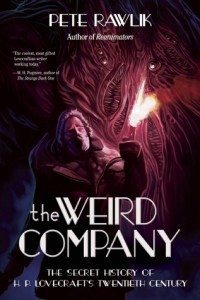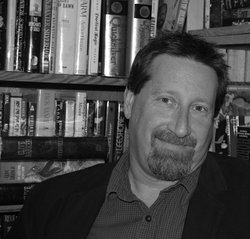Interview conducted by Dave Goudsward

Hellnotes: The Weird Company is your second novel and is a continuation of the story in the first book Reanimators. In the first book, your focus was on Dr. Stuart Hartwell, introducing him as a rival to Lovecraft’s Herbert West. But your book is not just a retelling of the reanimator saga through Hartwell, Hartwell is witness to many other of the Lovecraft stories. Is it safe to say your concept is that the stories are contiguous, not just standalone stories?
Pete Rawlik: I think you don’t have much of a choice but to accept that these stories are contiguous. The stories are linked by the setting of what I think of as the Miskatonic Valley (Lovecraft Country), often by the presence of the Necronomicon, and by some crossover by characters from one story to another. In many ways Lovecraft’s Miskatonic Valley stories can be looked at as a history of the area, with the setting as the main character. I think Lovecraft was world-building, and was even trying to fit his earlier Dreamlands fantasy into his milieu. I took my cue from that concept and ran with it. The story of Dr. Stuart Hartwell, who I lifted from “The Dunwich Horror, “happens to parallel that of Herbert West for a very specific reason, and that happens to be The Weird Company. In developing The Weird Company I wanted to include Herbert West as a character, but his timeline (by Lovecraft and the multi-author sequel round robins) didn’t allow for it. So I decided to create a character with a similar history and skill set that I could use for my own purposes. Originally I just wrote some stories to get an idea of who he was, what his motivations were. Those stories just kept growing and eventually became the novel Reanimators.
HL: How did you establish the chronology used in the stories? Is Lovecraft that linear or is there tweaking involved?
PR: Thankfully most of the work for this was done by the very talented Peter Cannon in his book The Chronology Out of Time which lays out dates in most of Lovecraft’s stories. In a few places I had to expand on the details and fill in events between dates, but most of the heavy lifting was already done. Lovecraft is very detailed when it comes to the chronology of his stories and very linear. He occasionally does flashbacks, but these are usually well marked in the text and easy to spot. It really made building these details relatively easy.
HL: You don’t just reference Lovecraft’s stories. Is there such a things as canon writers/writings?
PR: I included references to a lot of stories from a lot of different writers, mostly stories that I like or seemed to be able to easily fit in without too much forcing. I’ve been reading and collecting weird fiction, and specifically Lovecraftian Horror, for more than forty years, and in that time I built up these weird linkages between stories, some of which made sense, and some that didn’t. There’s a concordance to Reanimators that I’ve written that helps remind me about who came from where. In this idea I am indebted to two masters of this: Alan Moore and Kim Newman; they really paved the way for this kind of work. As for canonical writers and writings that’s a tough question. There is no list that says these stories are part of the canon, and these aren’t, but there are some divisions that are apparent (at least to me). For example, most of August Derleth’s work isn’t set in the same universe as Lovecraft’s stories, there are parallels, but subtle clues that tell you these aren’t the same. Both universes contain an Innsmouth, but in Derleth’s version the influence of the Deep Ones is older than Lovecraft’s, and the timeline for the Federal invasion is different. Also, Derleth’s universe is more fantastic than Lovecraft’s, with wood carvings and clay masses coming to life or transforming their owners. Of course the biggest difference is that in Derleth’s version Lovecraft is a character who wrote fiction published by Arkham House which imparts important knowledge concerning the mythos. Brian Lumley’s stories are rooted in Derleth’s work, and while I enjoy both these authors, I tended to avoid these contributions, though there is an entire chapter inspired by Derleth’s “The Survivor.”
HL: Any authors whose work you wanted to allude to, but couldn’t make fit?
PR: Oh absolutely – tons of people I wanted to include but couldn’t because there was no easy way to fit their creations in. I’m a fan of Ramsey Campbell’s work, but really need to sit down and do a chronology of his stories before I try and work his stuff in. I have similar issues with Michael Shea and Wilum Pugmire. I need to see the entire body of work to see how it fits together and where connections might be logical. As both Campbell and Pugmire are actively contributing to the field it would be presumptuous of me to attempt that to any real depth, although I admit to wanting to have characters visit Sesqua Valley or Goatswood.
HL: The Weird Company continues the story from the first book, but Dr. Hartwell is no longer the narrator. Any particular reason for your choice as the voice of the second book?
PR: I wanted to take the emphasis off of Hartwell for The Weird Company, mostly because it didn’t make sense at certain points in the book, and because Hartwell simply knows too much, he’s jaded. I needed someone who was new to the mythos and could be told “Everything you know is wrong.” Robert Olmstead, the narrator from “The Shadow over Innsmouth” is perfect for this, his contact with the mythos is limited, and really open to interpretation, or re-interpretation. He’s not a mystic or a scholar or a veteran of twenty-five years of living in Arkham, he’s fresh meat and easy to pull in different and unexpected directions.
HL: The first book used “Herbert West—Reanimator” as a starting point. Which story do you consider the starting point for this adventure?
PR: The Weird Company functions as a direct sequel to both “At the Mountains of Madness” and “The Shadow Over Innsmouth.” It also serves as a prequel to “The Thing on the Doorstep” and has a weird relationship to “Through the Gates of the Silver Key.” Actually, there are three distinct sequels to “At the Mountains of Madness” in this book. It’s a story ripe for reexamination, spin-offs and sequels. There are so many characters, some that lived, some that died, they should all have stories to tell.
HL: You also write short fiction involving Lovecraftian-based protagonists. Are they part of your book universe or are they more apocryphal?
PR: Early on before I conceived of Reanimators or The Weird Company I wrote some stories that I might not be able to rectify with my later works. Additionally, some of my stories paint a very bleak and not too distant future. Here, I’m relying on the idea of possible futures as envisioned and mediated by the Great Race of Yith. Other than these, yes, I’m working hard to try and link up all my stories into one coherent universe, or at least multiverse. So Reanimators is linked to The Weird Company and to my Professor Peaslee short stories.
HL: You’re also a pulp aficionado and have been known to toss an occasional throwaway reference into the mix, such as cameos by Charlie Chan or passing references to Indiana Jones. Is there anyone in The Weird Company you’re particularly smug about sneaking into the mix?
PR: Actually I’m smug about sneaking a lot of characters from pulp fiction into Reanimators, but I didn’t have as much of an opportunity in The Weird Company. That said, I have to say that I’m really proud of building the bridge that links “At the Mountains of Madness” with John W. Campbell’s “Who Goes There?” which I have always thought was a thematic sequel.
HL: Is there a third book forthcoming? Or any other Herbert West projects you’re reanimating?
PR: I’m working on a third novel, Reanimatrix, which will follow Detective Robert Peaslee’s investigation into the death of Megan Halsey. It’s a noir mystery set in 1928 Arkham and I hope to invoke some of the classics of the genre including Laura, Chinatown and The Big Sleep, but mixed with the Cthulhu Mythos. Also on the horizon, is a book I’ve edited with Brian M. Sammons, Legacy of the Reanimator, which will include Lovecraft’s original story and two long out-of-print round robins, “Herbert West-Reanimated” and “Herbert-West Reincarnated,” as well as other tales both old and new. This book should be out in time for the 30th Anniversary of the film Reanimator.









